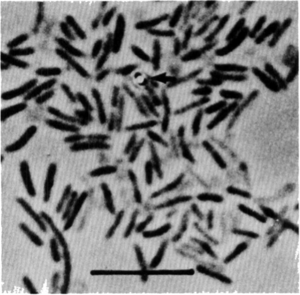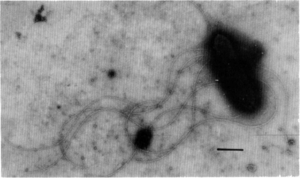Amphibacillus xylanus: Difference between revisions
No edit summary |
No edit summary |
||
| Line 38: | Line 38: | ||
[[File:Amphibacillus_xylanus_image_2.png|thumb|alt=Electron micrograph of Amphibacillus xylanus|Electron micrograph of ''Amphibacillus xylanus''.]] | [[File:Amphibacillus_xylanus_image_2.png|thumb|alt=Electron micrograph of Amphibacillus xylanus|Electron micrograph of ''Amphibacillus xylanus''.]] | ||
Amphibacillus xylanus was first isolated from alkaline compost of manure with grass and rice straw and it can survive in a variety of environments because of its multiple metabolic pathways. It is a chemoorganotroph and can be found in both anaerobic and aerobic conditions because it is a facultative anaerobic organism. | Amphibacillus xylanus was first isolated from alkaline compost of manure with grass and rice straw and it can survive in a variety of environments because of its multiple metabolic pathways. It is a chemoorganotroph and can be found in both anaerobic and aerobic conditions because it is a facultative anaerobic organism. Even though Amphibacillus xylanus does not have a respiratory chain, the microbe has the same cell growth rate and cell yield under both strict anaerobic and aerobic conditions. This is because similar high amounts of ATP are produced under both conditions. These bacterium can survive in temperatures from 25° C to 45° C, however, it cannot grow at 50° C. | ||
<h2> <span class="mw-headline" id="References">References</span></h2> | <h2> <span class="mw-headline" id="References">References</span></h2> | ||
Revision as of 14:17, 1 April 2013
Classification
- Kingdom - Bacteria
- Phylum - Firmicutes
- Class - Bacilli
- Order - Bacillales
- Family - Bacillaceae
- Genus - Amphibacillus
Species
|
NCBI: Taxonomy |
Amphibacillus xylanus
Description and Significance
Amphibacillus xylanus is a Gram positive, spore-forming, and chemoorganotrophic bacterium that was isolated from composts of manure with grass and rice straw. They are also facultative anaerobic organism that can grow in several different environments. However, it lacks cytochrome, quinone, and catalase. This helps explain the method of metabolism that Amphibacillus xylanus relies on.
Amphibacillus xylanus is also flagellated and motile, and it maintains many of the characteristics known to Amphibacillus. For example, the cells are rod-shaped and are 0.3 to 0.5 micrometers in diameter and are 0.9 to 1.9 micrometers long. The spores are oval in shape and heat resistant. The sporangia where the spores are formed are lysed and the spores are then released. These spores are formed under both aerobic and anaerobic conditions. Amphibacillus xylanus does not grow in nutrient broth, but it produces ethanol, acetic acid, and formic acid under anaerobic conditions and acetic acid under aerobic conditions from glucose. When colonies are grown on glucose agar, the colonies are small, circular, smooth, convex, entire, and white after only one day of incubation.
The microorganism grows ideally at pH values between 8 and 10, but it cannot grow at pH 7. The bacterium also contains a considerable amount of saturated straight-chain fatty acids, and little of its genome matched the genome of other bacterium.
Genome Structure
It has been found that Amphibacillus xylanus is not related to representative species of the genera bacillus, which include clostridium and sporolactobacillus. In fact, little of its genome has matched any other bacterium.
Metabolism and Life Cycle
One of the bioenergetics properties of Amphibacillus xylanus is the fact that the flavoprotein NADH oxidase from Amphibacillus xylanus consumes oxygen to produce hydrogen peroxide. Furthermore, it is believed that NADH is in control of the intracellular redox balance of the cell under aerobic conditions. Despite the fact that Amphibacillus xylanus lacks a respiratory system and hemeproteins, catalase, and peroxidase, it is still able to grow efficiently and it has the same growth rate under both anaerobic and aerobic conditions. It is able to do so because it has aerobic and anaerobic pathways that produce similar amounts of ATP.
Ecology and Pathogenesis
Amphibacillus xylanus was first isolated from alkaline compost of manure with grass and rice straw and it can survive in a variety of environments because of its multiple metabolic pathways. It is a chemoorganotroph and can be found in both anaerobic and aerobic conditions because it is a facultative anaerobic organism. Even though Amphibacillus xylanus does not have a respiratory chain, the microbe has the same cell growth rate and cell yield under both strict anaerobic and aerobic conditions. This is because similar high amounts of ATP are produced under both conditions. These bacterium can survive in temperatures from 25° C to 45° C, however, it cannot grow at 50° C.
References
Author
Page authored by Lauren Jackson and Hillary Albert, students of Dr. N. Walker at Michigan State University.


